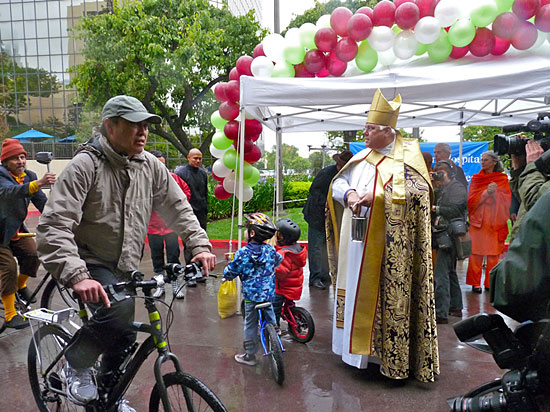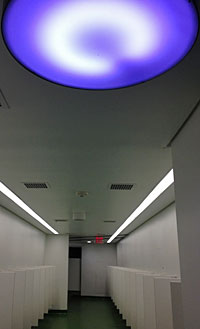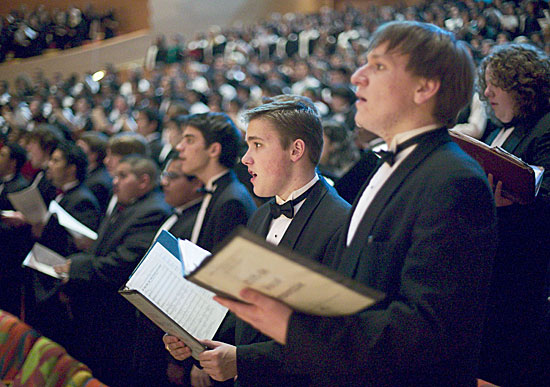Get ready to ramp up on Wilshire
May 11, 2012
We got through Carmageddon last summer. Now it’s time to navigate Ramp Jam.
Long-running closures of the 405 Freeway’s Wilshire Boulevard ramps are set to begin on Friday, June 22, bringing fresh challenges to an intersection that’s already among the nation’s worst.
Anxious residents and employees in the area have been girding for the start of the ramp work for months. Some online wags have dubbed it The Rampture, while others who live nearby refer to it ominously as “the next shoe to drop.”
Whatever you call it, the work is needed to construct sweeping, 30-foot-high flyover ramps that will improve traffic flow and safety at the perennially jammed intersection, as this Metro video explains. Currently, vehicles moving on and off the freeway must execute a complicated merge with heavy traffic on Wilshire—a situation the new flyover ramps are intended to alleviate.
The first of eight ramps to close will be the westbound Wilshire on-ramp to the northbound 405 and the northbound 405 off-ramp to westbound Wilshire. Both will be out of commission for 90 days starting June 22. Work on the other ramps will proceed in segments after that, with planned closures ranging from 90 days to 14 days. Delays and detours are expected as workers demolish and rebuild the ramps, working around the clock to finish the job.
In all, work on the Wilshire ramps is expected to take about a year.
Supervisor Zev Yaroslavsky is set to appear with other officials at a news conference today, Friday, May 11, to present ways of coping with the extended closures.
The official mantra for getting through it all: Plan ahead. Adjust your travel times. Share the ride.
In other words, get ready for a long, blocked summer—and then some.
The June 22 start date was chosen, in part, because it will come after the end of the academic year for LAUSD and private schools in the area. The work also will be getting underway following the mid-June flurry of commencement activity at UCLA.
Meanwhile, Metro’s Commute Services Department is seizing the moment and hoping to help residents, workers and employers navigate the disruption, and, perhaps, discover some new ways of getting around that will outlast the temporary pain during construction.
Then, later in the summer, Carmageddon will make a return appearance. The weekend shutdown of the entire freeway is the flipside to last summer’s successful, shorter-than-expected closure required to demolish one side of the Mulholland Bridge. This summer, workers will tear down the other side of the bridge during Carmageddon II. A date for the sequel has not yet been announced.
When completed in 2013, the 405 Project is expected to expand and modernize the heavily-travelled stretch of freeway that runs through the Sepulveda Pass, from the 10 Freeway to the 101 Freeway. The $1.034 billion project will add a 10-mile northbound carpool lane along with lane and ramp improvements and three rebuilt, seismically reinforced bridges across the freeway.

Where giants collide: some of the heaviest traffic in the nation occurs where Wilshire and the 405 meet.
Posted 5/11/12
Bike Week’s cycle of celebration
May 10, 2012
Bicycles keep gaining traction in Los Angeles County. With the most recent edition of CicLAvia behind us, it’s time to celebrate pedal power during the 18th Annual Bike Week, May 14-18.
Metro, the Los Angeles County Bicycle Coalition and other community organizations are partnering for five days of bike festivities, beginning Monday with a 10 a.m. kick-off celebration at the University of Southern California’s Galen Center. New initiatives to promote bicycling will be announced at the event.
After that, on Tuesday, clergy of various religions will perform the 9th Annual Blessing of the Bikes at Good Samaritan Hospital from 8 a.m. to 9:30 a.m. Cyclists who attend can also receive the earthly blessings of a free bike check-up and breakfast.
On Wednesday, cyclists can “test pedal” the new Expo Line bike lanes on a mid-city ride, which meets at the Expo Park/USC station at 8 a.m. and departs at 8:30 a.m.
Thursday, May 17, is Bike to Work Day. Metro and other local transit agencies will give free rides to anyone with a bike or a helmet, and local cycling organizations and businesses will host dozens of pit stops with free refreshments and giveaways. After the workday is over, participants can join fellow riders at one of several after parties.
The week concludes on Friday with Bike to School Day, which takes aim at reducing traffic congestion in school zones.
Bike Week will give the public 5 days’ worth of reasons to avoid the hassles of driving while getting some healthy exercise with L.A.’s growing cycling community. To keep safe on the roads, check out these quick tips from Metro.
Posted 5/9/12
What your mother isn’t telling you
May 9, 2012

Say it with geraniums this year at the Arboretum, or explore some other Mother's Day options around the county.
She’ll smile, hug you and say thanks—maybe more than once.
She’s your mother, after all. But deep inside, you can’t help wondering whether your time-honored Mother’s Day brunch-and-bouquet routine has Mom thinking you’re just a little bit challenged in the creativity department.
Here’s your chance to change her mind. Los Angeles County facilities are offering a wide range of out-of-the-ordinary diversions to explore this Mother’s Day weekend.
For instance, it’s a great time to check out the 124 acres of the scenic Los Angeles County Arboretum & Botanic Garden. On Saturday and Sunday, May 12 and 13, the International Geranium Society will hold a Mother’s Day Geranium Show. Local hobbyists, enthusiasts and experts will display exotic varieties of the flower, cultivated from plants originating in South Africa. If your mother has a green thumb of her own, show her the new “Garden for all Seasons,” which demonstrates the latest in environmentally friendly, year-round cultivation of fruits and vegetables.
If your mother is a music lover, why not take her to the 9th Annual Mother’s Day Jazz & Blues Extravaganza at the John Anson Ford Amphitheatre? Every seat in the roofed, outdoor venue is no more than 94 feet from the stage and guests are welcome to bring a picnic. Purchase tickets online to save a few bucks.
If mom’s more an Earth mother type, perhaps she’d enjoy an outing to the Natural History Museum (and possibly getting there on Metro’s brand-new Expo Line). In addition to the new Dinosaur Hall (motherhood bonus points: the only known fossil of a pregnant plesiosaur), there’s also Hall of Gems and Minerals and the Insect Zoo to explore, along with the Butterfly Pavilion, which boasts 53 unique living species. For even more bonus points, take a walk down memory lane in the famous Exposition Park Rose Garden, directly to the south of the museum.
Outside these L.A. County offerings, there are other goings-on Mother’s Day weekend, like free babysitting and a spa Friday at UCLA’s Mother’s Week, a family bluegrass jam at the Fowler Museum and card-making and stories at the Craft and Folk Art Museum.
If you absolutely must do the brunch thing, combine it with a trip to lush and rustic Topanga Canyon, where the Will Geer Theatricum Botanicum Mother’s Day event features dance, music and circus performances.
Your mother has eaten eggs, muffins and toast before. She probably hasn’t seen an aerialist perform while she’s eating them. Now is as good a time as any to give her a brand-new experience. What a smart, cultured son or daughter you’ll be!
Posted 5/9/12
Benched Lakers star still on a mission
May 8, 2012

Billboards like this represent the continuing collaboration between Metta World Peace and Los Angeles County.
“I was 110 percent wrong,” the suspended Laker says of decking an opposing player with a nasty elbow to the head. “People can say what they want. I’m not going to get down on myself because I made a mistake. I’m not perfect. But it’s not going to stop me from talking about mental health.”
And the Los Angeles County Department of Mental Health suddenly has a teachable moment on its hands.
For more than a year, the player formerly known as Ron Artest has been in a very public partnership with the mental health department, appearing at high school assemblies and in public service announcements to encourage young people to be unafraid of seeking psychological treatment. Dozens of billboards and transit ads with World Peace’s picture, along with the NBA logo and the L.A. County seal, carry the catchphrase: “You can do it.”
The campaign was, in a sense, testimony to the public rehabilitation and redemption of Artest, who was famously suspended for 86 games for brawling with fans in the Detroit Piston’s arena in 2004 when he played for the Indiana Pacers. Last year, World Peace—who credits a team of therapists for helping him with everything from parenting skills to anger management—was honored with the NBA’s good citizenship award.
But on Sunday, April 22, that goodwill vanished the moment James Harden of the Oklahoma City Thunder crumpled to the hardwood of Staples Center. World Peace had been pounding his chest after a dunk when he let loose with a powerful round-house elbow behind the left ear of Harden, who’d come face-to face with the pumped-up Lakers forward.
The fallout was swift. World Peace, suspended for 7 games, was widely criticized on TV, talk radio and internet postings as a thug who’d lost the right to be called World Peace, a fraud who preached mental health but who indulged his demons. He was, they said, back to being Ron Artest.In an a column for ESPN.com, former Lakers’ great Kareem Abdul-Jabbar put it like this: “In returning to his old ways, Metta has wasted all the goodwill, including the J. Walter Kennedy Citizenship Award, he earned when he was on his best behavior.” A sports columnist for the Orange County Register, Jeff Miller, was equally harsh, saying that World Peace had “tainted all the good things he has achieved in promoting mental health.”
But inside the Los Angeles County Department of Mental Health, the view was decidedly more nuanced. Experts there emphasized that mental health recovery is a process often accompanied by relapse.
“When I saw what happened in the game, I thought, man, the adrenaline just got out of control,” said Dr. Marvin Southard, the department’s director. “It was an ugly event but it seemed to me that it was not purposeful, rather an artifact of the emotion of the moment.”
For all of us, Southard said, “our aspirations and desires to do the right thing don’t always live up 100 percent to our actions…It doesn’t happen all at once. The goal is for the actual self to get closer to the ideal self day by day.”
As for the agency’s partnership with World Peace, Southard said: “I don’t feel embarrassed that the department is connected to someone who makes a mistake. I don’t know who hasn’t made one.”
For his part, World Peace said in an interview with Supervisor Zev Yaroslavsky’s website that the incident occurred simply because he got “over excited” after slamming down several dunks that reminded him of his performance as a younger player.
“I never thought I could reach that plateau again,” he said, adding: “It was pure excitement.”
World Peace said that, with his much improved game, he’s now working “all the time” with his therapist to keep from getting overtaken by emotion, as he did last month and in his earlier years. “She’s trying to show me how to play with less passion and still be effective.”
And that’s no easy lesson, he said, because this is “no kids’ game. I know people who throw more elbows than me. It doesn’t feel like a game to us. It feels like life or death.”
As he tries to reconcile the disconnect between his public image and his public mission, he can’t help feeling that he’s being judged more harshly than he should be in the situation.
“The only issue I have is people trying to single me out, trying to tarnish what I’m trying to do in the community. They try to destroy everything I’m working for.”
And those things, he said, “are bigger than basketball.”
Posted 5/8/12
LACMA docents mark 50 artful years
May 8, 2012
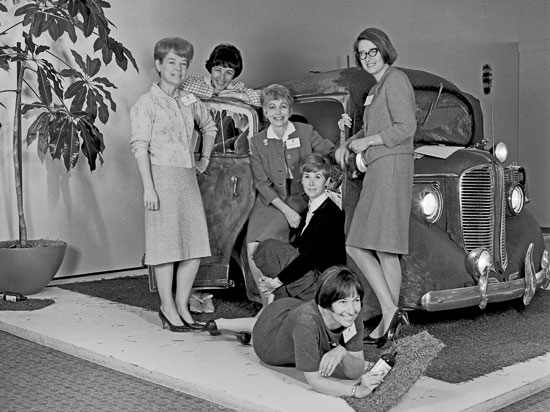
Terry Bell, second from left, and fellow docents defended Kienholz's "Back Seat Dodge '38" in LACMA's early years.
Terry Bell was a 34-year-old homemaker with two children in Westwood when art changed her life.
“It was the early ‘60s, and I had a good friend who did fundraising for the museum,” she remembers. “One day she said, ‘You’re a disgrace! You’re a college graduate and you don’t know anything about painting or sculpture.’ ”
At her friend’s insistence, she signed up for a then-new program to train docents at the Los Angeles Museum of History, Science and Art in Exposition Park, which at the time housed the county’s art collection. Now, 50 years later, she is an avid art collector, a Los Angeles County Museum of Art life trustee and a founding member of one of the largest docent organizations in the nation. She has exposed thousands of visitors to museum treasures, recorded acoustic guides for major exhibitions and worked against the censorship of controversial and important artworks.
And she traces it all to that decision a half-century ago to volunteer as a LACMA docent..
“It is just so rewarding,” says Bell, who this week is among the hundreds of honorees celebrating the golden anniversary of LACMA’s Docent Council. “Not only in terms of yourself, but in what you can give back to the community.”
Some 521 men and women belong to the Docent Council, a volunteer juggernaut whose members have led more than 2 million children and adults through the museum since it became an official entity in 1962.
More than a million Southern California schoolchildren have been led on field trips by LACMA docents; so have generations of adult visitors to the museum’s many exhibitions.
“We are definitely in the front lines,” says Judith Tuch, who chairs the council. “We provide the personal connection between the students and adults who come to the museum and the art they see. For many, it’s the first time they’ve ever been in a museum. For some, unfortunately, it may be the only time they’ll be in a museum.
“We encourage them to understand that this is a county museum, and that this is their place.”
The council grew from a small group of volunteers who explained art during the 1950s at what is now the Natural History Museum. Though visitors at that Exposition Park site mostly came to see dinosaurs and fossils, the county also had quietly been amassing fine art since the 1920s. Members of the Junior League, the Volunteer League of the San Fernando Valley and other local organizations offered informal tours of the gifts from such early donors as William Preston Harrison, Paul Rodman Mabury and William Randolph Hearst.
In 1961, amid planning for a separate Los Angeles County Museum of Art on Wilshire Boulevard, the groups joined forces to create a formal docent training program. Fifty-three women took the special classes in art history and elementary education.
After a provisional year, the Docent Council was officially formed, chaired by Glenn Cooper, a Junior Leaguer who later became a well-known arts patron in Sun Valley. Their goal: To train 200 docents in time for the official opening of LACMA in 1965.
The docents were key almost from the moment the new museum opened. In 1966, for instance, they rose to defend Edward Kienholz’s still-controversial “Back Seat Dodge ’38.” The piece, which depicts a beer-soaked encounter in a parked car, is so sexually charged that members of the then-Board of Supervisors denounced it as pornographic.
“I had met Ed Kienholz and talked to him about the exhibition, and I thought it was terrific,” Bell remembers.
 Eventually, the Supervisors decided the piece could be seen, “but the door to the car couldn’t be open unless a docent was there to explain it,” Bell says, recalling that at one point, she had to tour a group of clergy that included her own rabbi—whom she had to shush with the admonition that she listened to him every week, so he should do her the courtesy of returning the favor.
Eventually, the Supervisors decided the piece could be seen, “but the door to the car couldn’t be open unless a docent was there to explain it,” Bell says, recalling that at one point, she had to tour a group of clergy that included her own rabbi—whom she had to shush with the admonition that she listened to him every week, so he should do her the courtesy of returning the favor.
The piece—like later Kienholz exhibitions that Bell also guided—became a sensation and visitors mobbed the museum. “Five or six of us guided tours every 20 minutes,” Bell remembers, “almost around the clock.”
Since then, the council has grown along with the county in diversity and sophistication. Some 25 members are men and docents of all races, creeds, ages and backgrounds lead tours in multiple languages.
Now overseen by the museum’s Education Department, the group has a training regimen that includes extensive coursework in art history and touring techniques and a 2-year provisional period. No member can tour adults without spending at least 5 years doing school tours.
“We have several attorneys in the current [provisional] class,” says Patsy Palmer, a child psychotherapist and longtime LACMA volunteer who now trains incoming docents. “One man in my group is a retired doctor.” All the new docents, she says, “are highly qualified and uniquely skilled.”
“We’ve come so far,” agrees Bell, who says she can’t wait to see how visitors respond to “Levitated Mass” and other upcoming attractions. “We’re really in a marvelous place.”
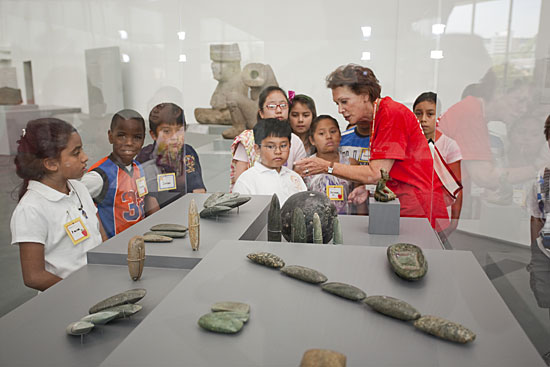
LACMA docent Patsy Palmer has shown the museum to legions of children. The Docent Council turns 50 this week.
Posted 5/2/12
Way to go, Hollywood Bowl
May 7, 2012
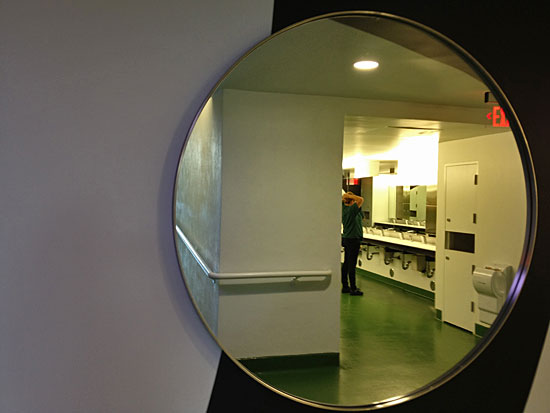
Glossy green floors, dramatic mirrors, Dyson hand dryers and LED lighting are all part of the re-do.
With legendary headliners ranging from Glen Campbell to Smokey Robinson to Plácido Domingo on the 2012 bill, it’s not easy for a newcomer to break through at the Hollywood Bowl.
But it’s a safe bet that the new restrooms designed by Rios Clementi Hale Studios will have audiences cheering when they make their Bowl debut this summer.
With sustainable features like Dyson hand dryers, LED lighting, water-saving fixtures, graphics inspired by the Bowl’s Art Deco architecture, and glossy green floors intended to bring the outdoors in, the restrooms represent a stark departure from the old, dark spaces that used to make intermission such a drab interlude.
[Updated 9/20/12: The Bowl’s bathroom re-do is a finalist in the America's Best Restroom contest sponsored by Cintas. Cast your vote here.]
The Bowl is a Los Angeles County park—albeit one with a worldwide reputation for glamour, fireworks and star-studded concerts—and the $3 million makeover was funded by Proposition A park improvement funds.
The bathrooms also feature reengineered layouts, dramatic mirrors, new privacy partitions between urinals and lighting accents to make sure patrons keep moving toward unoccupied facilities in the back, rather than creating unnecessary bottlenecks at the front of the line.
The new facilities were unveiled Monday evening at a Bowl reception along with some less noticeable but equally important off-season improvements like $600,000 in concrete repairs, including the replacement of a stairway built in 1954. Also underway, and expected to be finished in coming weeks, is the $2 million replacement of the moving sidewalk (also known as a speed ramp) that helps 75% of Bowl patrons get up the hill to their seats.
If you’d like to test drive the new and improved Bowl—and listen to some world-class music while you’re at it—tickets are on sale now. The season gets off to a big start June 22, with opening night festivities hosted by Julie Andrews and featuring Reba McIntyre, Chaka Khan and the Hollywood Bowl Orchestra conducted by Thomas Wilkins.
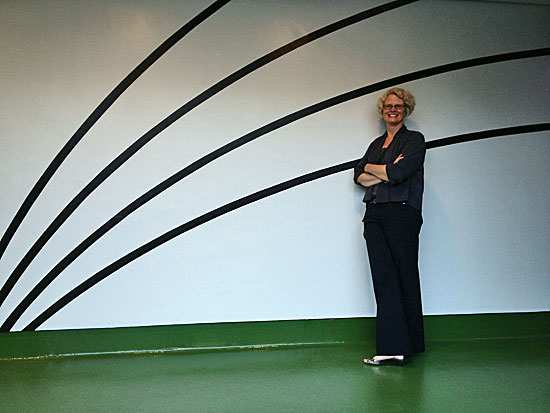
Julie Smith-Clementi of Rios Clementi Hale, outside one of the Bowl bathrooms redesigned by her firm.
Posted 5/7/12
Seniority has its privileges
May 3, 2012
This month, it pays to be a senior—whether you walk on two legs or four.
The county’s Department of Animal Care and Control’s new promotion is called Super Senior May: Never Too Old to Play. Throughout the month, people over 60 will have their pet adoption fees waived at county shelters.
And everyone, regardless of age, will get discounted fees when they adopt any pet that is five years old or more.
Check out the department’s Facebook page for more information, and see whether you can find “puppy love” all over again with an older pet.
Posted 5/3/12
Ah, to be young and in tune
May 3, 2012
More than 900 young vocalists from 25 area high schools are about to see first-hand that, yes, believe it or not, a career in music is possible.
On Friday, May 5, the 23rd Annual High School Choir Festival will bring students from all parts of the county to Walt Disney Concert Hall for a chance to sing under the baton of Grant Gershon, Music Director of the Los Angeles Master Chorale. By getting top-notch pros involved with the young singers’ preparation, the Grammy-nominated Chorale hopes to foster a lifelong appreciation for the arts while encouraging aspiring musicians.
“Being able to work with the chamber singers they see that level of experience, the life of a professional singer,” said Lesili Beard, education programs manager for the Chorale. “There are professionals in the Master Chorale now who once participated in the high school chorus.”
Friday’s festival is free to the public, but tickets are required, and will be available on a first-come, first-served basis starting at 9 a.m. in the Walt Disney Concert Hall lobby.
About a year ago, individual choir programs were vetted for participation. Program size, past participation and representation of the diverse communities of Los Angeles County were all factors considered. For the chosen programs, the event becomes one of the year’s highlights.
“As a choir director, it gives my program incentive,” said Marsha Lynne Taylor, director of the Grant High School Vocal Ensemble in Van Nuys. “If you can imagine some of the kids never going to a music hall, never going to a concert… and here they find themselves performing at the Disney Hall.”
The students don’t come unprepared. After the selection process, Gershon met with choir directors to go over the musical selections and offer his personal edits and instructions. After that came numerous practices and rehearsals, assisted by members of the Chorale. Finally, the Chorale held two large rehearsals with about 450 students each (“to make sure the young performers don’t go into shock,” joked Beard).
At 11 a.m. on the day of the event, student singers and their audience will watch a complimentary performance by the Master Chorale and hear a demonstration of the Disney Hall’s massive concert organ.
At 1 p.m., the student program will begin, presenting songs spanning multiple languages and styles. The show will conclude with a rendition of Joseph Haydn’s The Heavens Are Telling, sung in unison by the full group.
The end result is surprisingly crisp, said Tom Pease, director of the William Howard Taft High School Vocal Ensemble in Woodland Hills, whose choirs have participated in the event for about the past 15 years.
“The kids are well-rehearsed and [Gershon] does a really great job of keeping them together” said Pease. “What you end up with is a really powerful, rich, full sound.”
Posted 5/3/12
E-stockpile found at assessor’s office
May 3, 2012
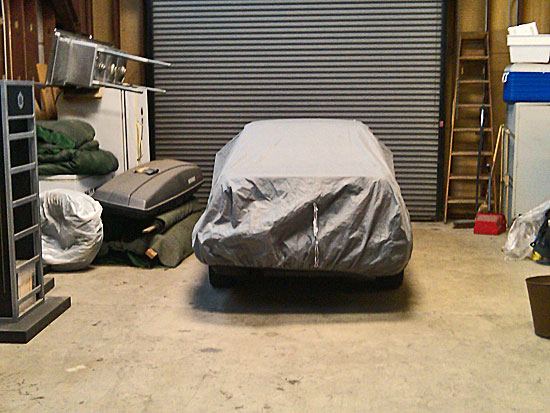
Assessor's equipment shared space in this storage facility with the landlord's car, bikes and mattresses.
As Los Angeles County was tightening its belt in recent years, its assessor’s office was sitting on a cache of more than a half-million dollars’ worth of brand-new electronics equipment it had stockpiled but never used, a newly-released county audit found.
The auditors discovered some $654,000 worth of never-used equipment, ranging from laptops to laser jet printers, languishing in storage at the Hall of Administration after it was purchased between fiscal years 2001-2 and 2009-10.
“A lot of the equipment was still brand-new, still sealed with the original vendor tape,” said David Aldava, an intermediate accountant-auditor who was part of the team that looked into technology in the assessor’s office.
Aldava’s team also made another unusual discovery: The department had improperly stashed pallets loaded with other computers, printers and tech equipment—some still functioning, some headed to the junk pile—in an unlocked, leased storage facility in Signal Hill, where the county-owned equipment shared space with the landlord’s car, bicycles, refrigerators, mattresses and even a bar sign or two.
The equipment ended up in the storage facility—next to the assessor’s South District office—after employees initially told auditors that the department had no surplus electronics. Eventually, though, the staff “told us that they had previously moved the surplus items from other locations to the storage building in an attempt to hide the equipment from us,” according to an April 13 report from Auditor-Controller Wendy Watanabe.
In a response to the audit filed last month, the department concurred with virtually all of the auditor’s 25 recommendations, most aimed at tightening accountability, record-keeping and security and ensuring that IT equipment is purchased only when needed.
Assessor’s spokesman Louis Reyes said the office is “fully cooperating” in correcting problems uncovered in the audit. “The assessor wants to address these concerns fully,” he said.
Assessor John R. Noguez was elected in November, 2010, and was not in charge during the period in which the new equipment was stockpiled, Reyes noted.
The audit comes as a separate, broader review, ordered by the Board of Supervisors, is underway to examine how the assessor’s office operates across the board. The office has come under fire for allegedly granting preferential treatment to some property owners. Noguez also shocked the supervisors recently when he disclosed a large, unprecedented disparity in property tax projections that could leave the county with a $50 million hole in its budget.
The technology audit, conducted last year and provided to the Board of Supervisors last month, offered its own set of unexpected discoveries.
“This warehouse issue really took us by surprise,” Watanabe said—especially when employees initially refused to let the auditors into the Signal Hill facility, claiming it would take a month to reach the landlord and get his permission for access. “That really piqued our interest.”
It turned out that an effort was underway, apparently, to thwart auditors from discovering an abundance of surplus equipment, which is not allowed under county policy. “They started to dump everything to Signal Hill…We finally did get in and saw stacks and stacks of used computers,” Watanabe said. “They didn’t want us to see it, to cover up that they’d initially lied.”
Even as the used computer equipment was piling up, the department was also acquiring the stacks of new and unneeded electronics—apparently part of a use-it-or-lose strategy of spending IT funds at the end of fiscal years rather than allowing unspent money to revert to the Chief Executive Office’s overall county budget, the audit found.
Beyond the cost of the equipment itself, the department overpaid by not waiting to buy the items until they were actually needed. Because technology prices tend to decrease over time, the assessor’s office ended up paying at least $93,000 more than it should have, the audit found.
Despite the huge build-up in excess tech equipment being stored, the assessor’s office still had plenty of electronic devices to go around, it appears. The audit found that 324 of the department’s 1,425 employees had at least two computers assigned to them—and 57 had three or more.
“To us, this is just ridiculous,” Watanabe said. “There’s really no business reason to justify why someone would have three or more computers.”
The employees themselves admitted as much to county auditors when asked about those second or third computers.
“Oh, yeah, it’s just sitting in my trunk,” some said when questioned about laptops they’d been issued, according to Watanabe.
Having an unused laptop lying around the house or car has hidden costs, too, Watanabe said, since the county pays virtual network fees of $600 a year for each employee who logs onto the network from outside the office—whether a device is being used or not.
Then there were security lapses. The audit said that the assessor’s department disposed of some surplus equipment without first erasing county information from the devices’ hard drives. It also found that 22% of the department’s computers didn’t have any working anti-virus protection.
Although Watanabe said no fraud was uncovered, the audit found a system of lax controls and a cavalier attitude toward safeguarding county property.
As for the surplus devices stashed in Signal Hill, those have all been junked or donated since the audit, or will be soon, according to the department. And employees in the assessor’s office have begun working their way through that unused stockpile of new equipment.
Posted /3/12






